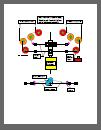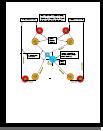| Combining Parallel SuperKites with Winches and Cranks | |
| A system of four parallel batteries of superkites with
four-line control may drive electrical generation gear using winches and
clutches for a systems of up to 1 MW or winches and crankshafts for more
powerful systems. Large tower-based wind turbines of 200-feet diameter
rotate as slow as 10 r/min and the blade tips can exceed 100 ft/s. A
system of superkites can pull through winches to drive a crankshaft and
electrical generation equipment at 10 r/min or 6 s/r.. The stroke of the
wind-driven crank may vary between the stroke of steam railway locomotives
(3 ft) and large marine diesel engines (up to 8 ft). Crankshaft roller
bearings would be required given the low rotational velocity and
tremendous shear forces that would be exerted on the crankshaft. For extreme stroke, a vertical single-throw crankshaft may be appropriate. Each battery of kites would exert a tensile force on cables attached to large-diameter winches that in turn drive small-diameter winches. The tensile force on four cables spaced at 90° intervals would drive the crank. The equivalent "gear ratio" of 9-to-1 combined with a crank stroke of 7 ft at 6 s/r would mean that each battery of kites would cover the equivalent horizontal distance of 63 ft within 6 s, yielding a kite velocity of 10.5 ft/s. We may assume the high-altitude wind to be blowing at a velocity of at least 66 ft/s. The wind drag on a stationary kite of
200-feet width by 50-feet height, with air density of 0.065 lb/ft3
, and velocity of 66 ft/s would calculate to 33,820 lbf for
drag coefficient
(Cd) of 1. A battery of 10 kites would yield 338,200 lbf at Cd=1 or drop to 250,000 lbf for a Cd=0.74.
A battery of 10 kites moving at 10.5 ft/s in a wind of 60 mi/h (88
ft/s) would yield a drag force of 350,000 lbf for a Cd=
0.75. The power of each battery of kites moving at 10.5 ft/s would be over
4900 kW or 4.9 MW. A high-altitude wind speed of 90 mi/h (132 ft/s) would
yield a drag of 858,000 lbf with Cd=0.75 and a
power level of 12.2 MW for each battery of kites moving at 10.5 ft/s
during each power cycle. Cables and bearings would have to be designed for
side forces or shear loadings that could exceed 10,000,000 lbf. Harry Valentine |

Images are in PDF format for clarity and easy sizing by reader. |

